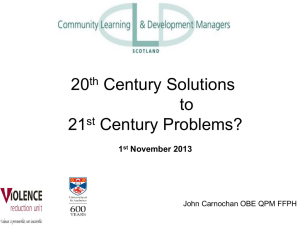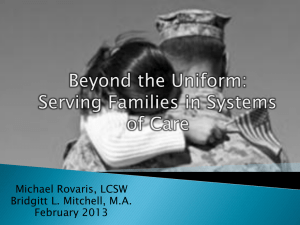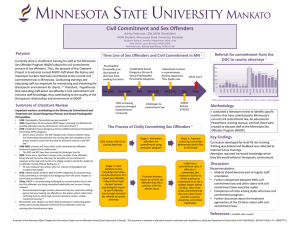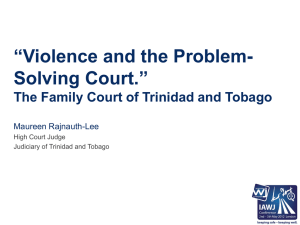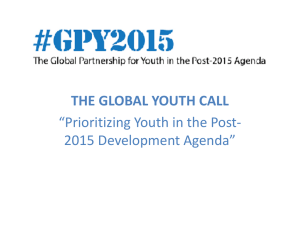Offender Focused Domestic Violence Initiative (OFDVI)
advertisement
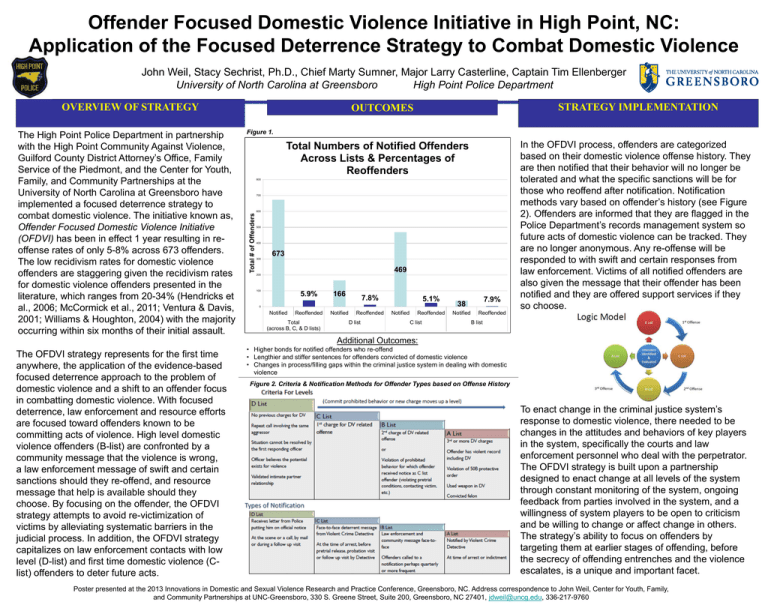
Offender Focused Domestic Violence Initiative in High Point, NC: Application of the Focused Deterrence Strategy to Combat Domestic Violence John Weil, Stacy Sechrist, Ph.D., Chief Marty Sumner, Major Larry Casterline, Captain Tim Ellenberger University of North Carolina at Greensboro High Point Police Department OVERVIEW OF STRATEGY Figure 1. Total Numbers of Notified Offenders Across Lists & Percentages of Reoffenders 800 700 600 Total # of Offenders The High Point Police Department in partnership with the High Point Community Against Violence, Guilford County District Attorney’s Office, Family Service of the Piedmont, and the Center for Youth, Family, and Community Partnerships at the University of North Carolina at Greensboro have implemented a focused deterrence strategy to combat domestic violence. The initiative known as, Offender Focused Domestic Violence Initiative (OFDVI) has been in effect 1 year resulting in reoffense rates of only 5-8% across 673 offenders. The low recidivism rates for domestic violence offenders are staggering given the recidivism rates for domestic violence offenders presented in the literature, which ranges from 20-34% (Hendricks et al., 2006; McCormick et al., 2011; Ventura & Davis, 2001; Williams & Houghton, 2004) with the majority occurring within six months of their initial assault. STRATEGY IMPLEMENTATION OUTCOMES 500 400 673 300 469 200 100 5.9% 166 7.8% 5.1% 0 Notified Reoffended Total (across B, C, & D lists) Notified Reoffended D list Notified Reoffended C list 7.9% 38 Notified Reoffended In the OFDVI process, offenders are categorized based on their domestic violence offense history. They are then notified that their behavior will no longer be tolerated and what the specific sanctions will be for those who reoffend after notification. Notification methods vary based on offender’s history (see Figure 2). Offenders are informed that they are flagged in the Police Department’s records management system so future acts of domestic violence can be tracked. They are no longer anonymous. Any re-offense will be responded to with swift and certain responses from law enforcement. Victims of all notified offenders are also given the message that their offender has been notified and they are offered support services if they so choose. B list Additional Outcomes: The OFDVI strategy represents for the first time anywhere, the application of the evidence-based focused deterrence approach to the problem of domestic violence and a shift to an offender focus in combatting domestic violence. With focused deterrence, law enforcement and resource efforts are focused toward offenders known to be committing acts of violence. High level domestic violence offenders (B-list) are confronted by a community message that the violence is wrong, a law enforcement message of swift and certain sanctions should they re-offend, and resource message that help is available should they choose. By focusing on the offender, the OFDVI strategy attempts to avoid re-victimization of victims by alleviating systematic barriers in the judicial process. In addition, the OFDVI strategy capitalizes on law enforcement contacts with low level (D-list) and first time domestic violence (Clist) offenders to deter future acts. • Higher bonds for notified offenders who re-offend • Lengthier and stiffer sentences for offenders convicted of domestic violence • Changes in process/filling gaps within the criminal justice system in dealing with domestic violence Figure 2. Criteria & Notification Methods for Offender Types based on Offense History To enact change in the criminal justice system’s response to domestic violence, there needed to be changes in the attitudes and behaviors of key players in the system, specifically the courts and law enforcement personnel who deal with the perpetrator. The OFDVI strategy is built upon a partnership designed to enact change at all levels of the system through constant monitoring of the system, ongoing feedback from parties involved in the system, and a willingness of system players to be open to criticism and be willing to change or affect change in others. The strategy’s ability to focus on offenders by targeting them at earlier stages of offending, before the secrecy of offending entrenches and the violence escalates, is a unique and important facet. Poster presented at the 2013 Innovations in Domestic and Sexual Violence Research and Practice Conference, Greensboro, NC. Address correspondence to John Weil, Center for Youth, Family, and Community Partnerships at UNC-Greensboro, 330 S. Greene Street, Suite 200, Greensboro, NC 27401, jdweil@uncg.edu, 336-217-9760


